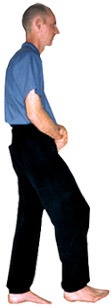Insight Meditation Online
Insight Meditation Workshop
by Ven. Pannyavaro
Technique in Walking Meditation
» Parts of the steps – illustrated
While meditation is usually associated with the sitting posture, insight meditation exercises can be practised while walking. Walking in insight meditation is essentially about the awareness of movement as you note the component parts of the steps. When walking meditation alternates with sitting meditation it helps to keep the meditation practice in balance.
Walking meditation is also a skilful way to energise the practice if the calming effect of sitting is making you dull or you are becoming over concentrated. Actually, it can be the preferred mode in insight meditation as it is meditation in action.
How to do it …
Establish your attentiveness by first noting the standing posture and the touch sensations of the feet at the start of the walking track. (You will need to find a walking path with a level surface from five to ten metres on which you walk back and forth). The arms should hang naturally with the hands lightly clasped in front. Allow the eyes to gaze at a point about two metres in front of you on the ground to avoid visual distractions. Then as you walk keep the attention on the sole of the foot, not on the leg or any other part of the body.
For the first five minutes you can note just three parts of the step: ‘lifting’, ‘pushing’, ‘dropping’. Then mentally note or label each step part by part building up the noting to its six component parts: ‘raising’, ‘lifting’, ‘pushing’, ‘dropping’, ‘touching’ and ‘pressing’ – concurrent with the actual experience of the movement.
While walking and noting the parts of the steps you will probably find the mind still thinking. Not to worry, keep focused on the noting of the steps if the thoughts are experienced just as ‘background thoughts’. However, it you find you have been walking ‘lost in thought’ you must stop and vigorously note the thinking as ‘thinking’, ‘thinking’, ‘thinking’. Then re-establish your attention on the movement and carry on. Also be careful that the mental noting does not become so mechanical that you lose the experience of the movement.
Try to do a minimum walking period of half an hour and build it up to a full hour. Strategically it is better to do a walking period before a sitting session as it brings balance into the practice. If you can alternate the walking and sitting sessions without any major breaks it will develop a continuity of awareness that naturally carries through into the awareness of your daily activities.


